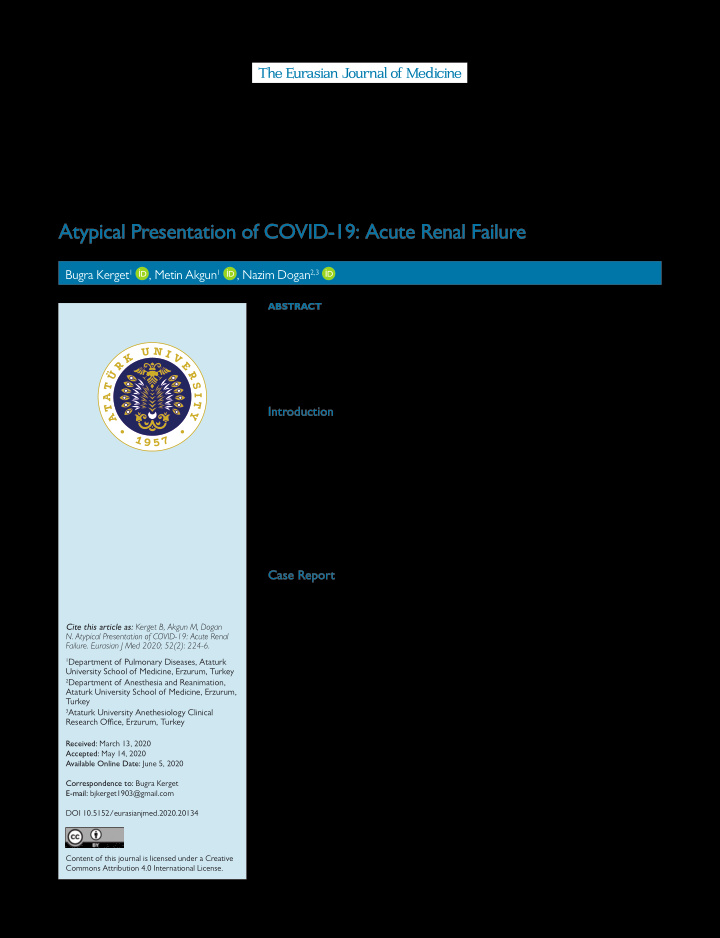



Letter to the Editor Eurasian J Med 2020; 52(2): 224-6 Atypical Presentation of COVID-19: Acute Renal Failure Bugra Kerget 1 , Metin Akgun 1 , Nazim Dogan 2,3 ABSTRACT Coronavirus disease (COVID-19) emerged in Wuhan, China, in December 2019 and rapidly became a global pandemic, with the number of confjrmed infections worldwide reaching 1 million by the start of April 2020 and 3 million less than a month later. COVID-19 can be encountered with difgerent clinical presentations. We present the case of a patient with COVID-19 in the etiology presenting with acute renal failure. Keywords: Acute renal failure, SARS-CoV-2, acute respiratuary distress syndrome Introduction Coronavirus disease (COVID-19) emerged in Wuhan, China, in December 2019 and rapidly became a global pandemic, with the number of confirmed infections reaching 1 million by the start of April 2020 and 3 million less than a month later, worldwide. Acute respiratory failure is among the leading causes of death due to COVID-19. Although it usually presents with respira- tory failure in older patients, individuals with mild COVID-19 may be asymptomatic or present with subtler symptoms, such as loss of taste and smell, sore throat, fatigue, and joint pain [1, 2]. In this case report, we describe a patient who presented to the emergency department with metabolic acidosis resulting from acute renal failure and was subsequently diagnosed with COVID-19 by nasopharyngeal swab polymerase chain reaction (PCR). Case Report An 80-year-old man presented to our emergency department with complaints of poor general condition and fatigue for the last 18 h. The patient’s relatives reported that the patient had not left his home for the past 15 days and had no contact with anyone suspected of having COVID- Cite this article as: Kerget B, Akgun M, Dogan 19. However, his son was delivering groceries to his home once a week. Based on the statement N. Atypical Presentation of COVID-19: Acute Renal given by his relatives, the patient had no known diseases and had undergone surgery in 2015 to Failure. Eurasian J Med 2020; 52(2): 224-6. repair an inguinal hernia. 1 Department of Pulmonary Diseases, Ataturk University School of Medicine, Erzurum, Turkey 2 Department of Anesthesia and Reanimation, On physical examination, the patient’s blood oxygen saturation was 86% at room temperature, Ataturk University School of Medicine, Erzurum, respiratory rate was 38/min, blood pressure was 170/110 mmHg, and brachial/radial heart rate Turkey was 150 beats/min and regular. The patient exhibited disorientation to time and space, and the 3 Ataturk University Anethesiology Clinical Research Offjce, Erzurum, Turkey results of neurological evaluation indicated that he had delirium. Posterior lung auscultation revealed bilateral basal inspiratory rales. Laboratory tests results were as follows: white blood Received: March 13, 2020 cells=16,760/µL, lymphocyte count=330/µL, neutrophils=15,870/µL, hemoglobin=20.4 g/dL, Accepted: May 14, 2020 Available Online Date: June 5, 2020 platelets=119,000/µL, lactate dehydrogenase=557 U/L, calcium=7.8 mg/dL, albumin=3.01 g/ dL, creatine=7.42 mg/dL, sodium=131 mmoL/L, blood-urea nitrogen=139.25 mg/dL, glomeru- Correspondence to: Bugra Kerget E-mail: bjkerget1903@gmail.com lar filtration rate=8.09 mL/min, troponin=88.1 ng/dL, D-dimer=3012 ng/mL, fibrinogen=890 mg/dL, prothrombin time=20.4 s, C-reactive protein=26.2 mg/dL, and ferritin=1124 ng/mL. DOI 10.5152/eurasianjmed.2020.20134 On blood gas analysis, pH=7.23, SaO 2 =92.4%, PaO 2 =74 mmHg, PaCO 2 =28.1 mmHg, and HCO 3 =14.4 mEq/L. Posterior-anterior chest X-ray showed increased prominence of the bronchovascular structures with areas of pleural-based consolidation in the lower lobes of Content of this journal is licensed under a Creative both lungs. Chest computed tomography revealed tubular and cystic bronchiectatic dilations Commons Attribution 4.0 International License. in the bronchial structures in the upper lobe of the left lung, especially those leading to the
Recommend
More recommend